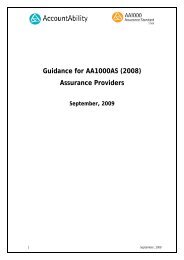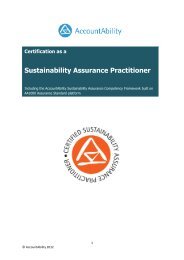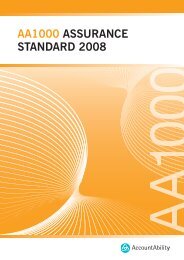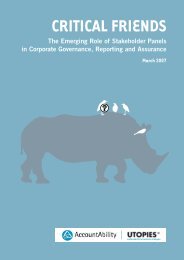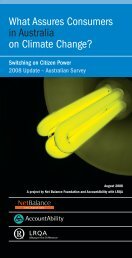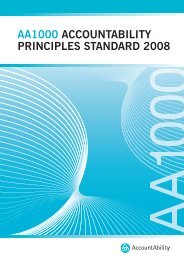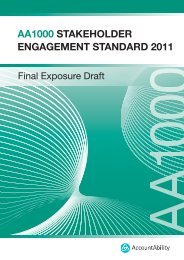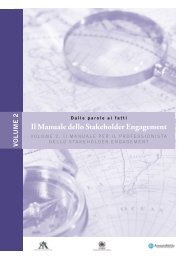The Stakeholder Engagement Manual Volume 2 - AccountAbility
The Stakeholder Engagement Manual Volume 2 - AccountAbility
The Stakeholder Engagement Manual Volume 2 - AccountAbility
Create successful ePaper yourself
Turn your PDF publications into a flip-book with our unique Google optimized e-Paper software.
Telephone Hotlines (continued)<br />
One-to-One Meetings<br />
STAGE 4<br />
Freephone hotlines for individual stakeholders to obtain information about an issue or<br />
project, to give feedback or to report problems. (continued)<br />
Examples in action<br />
Telephone hotlines are widely used by US companies as part of their ethics<br />
compliance programmes, response to Federal Sentencing Guidelines requirements<br />
– to allow employees to ‘blow the whistle’ on instances of fraud or unethical behaviour.<br />
Telephone hotlines have also been used in supply chain labour standards compliance<br />
programmes to allow local employees to report labour standards violations to a<br />
trusted third party intermediary.<br />
HP tracks consumer feedback about global citizenship issues that it receives via<br />
its customer support hotlines. <strong>The</strong>y receive several hundred customer enquiries each<br />
month on issues such as product recycling, environmental specifi cations, packaging<br />
and human rights. As well as responding to individual queries the company collates<br />
reports on overall levels of concern to better understand customer priorities and the<br />
importance of environmental and social issues in the marketplace.<br />
Individual Meetings with stakeholders, opinion leaders or organisational representatives.<br />
Key things to consider<br />
One-to-one meetings are often the fi rst step in engaging with a particular stakeholder<br />
or group. <strong>The</strong>y can be used for information gathering, exploring issues, getting<br />
feedback on how the company is viewed, ‘testing the water’, agreeing shared<br />
objectives or ground rules and building trust with key stakeholders before going on<br />
with wider stakeholder engagement.<br />
One-to-one meetings provide a ‘safe’ space where stakeholders can discuss concerns<br />
without having to take or defend a public position.<br />
Individual meetings are rarely considered or reported on as part of corporate<br />
stakeholder engagement programmes, but day-to-day individual meetings with<br />
key stakeholders including investors (including ‘responsible investment’ funds),<br />
institutional customers, regulators, politicians and offi cials and strategic suppliers<br />
are one of the most important ways in which expectations and issues are discussed).<br />
Examples in action<br />
Telefónica regularly meets investors and analysts who have adopted socially and<br />
environmentally responsible investment criteria to discuss performance, risks as<br />
well as the strategic signifi cance of Telefónica’s corporate responsibility efforts.<br />
<strong>The</strong> company’s participation in the Carbon Disclosure Project (CDP), which provides<br />
a secretariat for the world’s largest institutional investor collaboration on the<br />
business implications of climate change, is one outcome of these one-on-one<br />
meetings.<br />
THE PRACTITIONER'S HANDBOOK ON STAKEHOLDER ENGAGEMENT | 101



